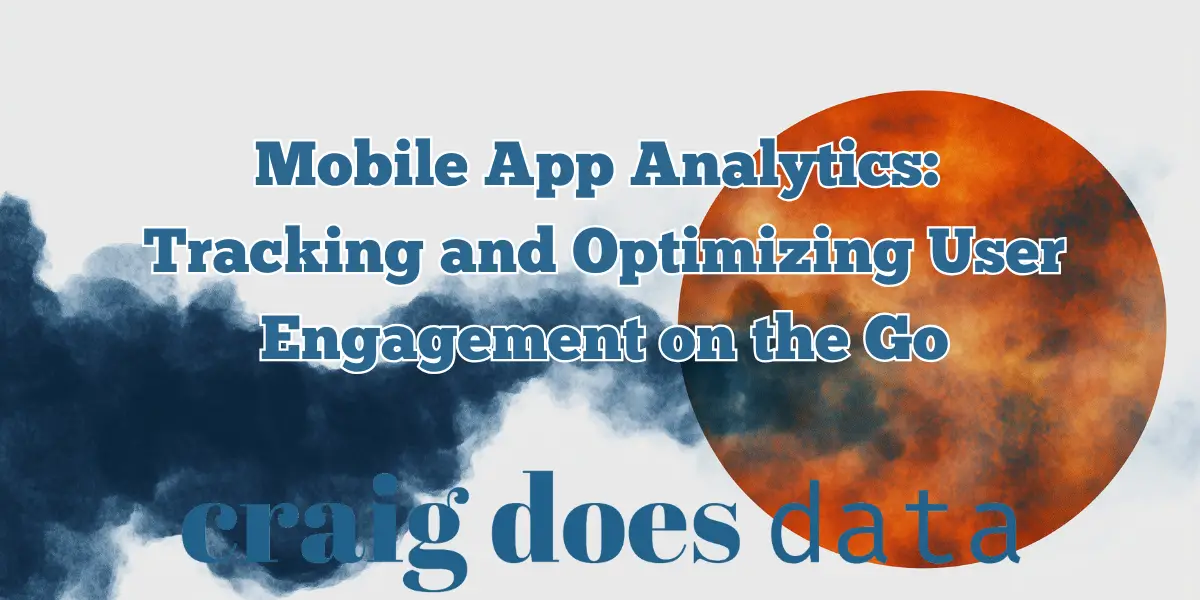
Mobile App Analytics: Tracking and Optimizing User Engagement on the Go
Mobile app analytics has become an integral part of the app development and marketing ecosystem. With the number of smartphone users surpassing billions worldwide, app developers and marketers need reliable methods to gauge how their users interact with their products. Understanding user engagement is no longer a luxury—it is a necessity for any app aspiring to gain and maintain a competitive edge. The path from an innovative idea to a successful mobile application hinges on sustained user engagement, and analytics is the compass that helps you navigate.
By collecting and examining data on how users interact with your app, you can glean valuable insights into what captivates users, what leads them to convert, and what ultimately causes them to churn. In this article, we will delve into the essentials of mobile app analytics, illustrating why it is crucial for app success and how to leverage key metrics and tools to achieve top-tier user engagement. Our goal is to guide newcomers and seasoned professionals alike through the intricacies of tracking and optimizing engagement, ensuring that your app not only attracts users but keeps them coming back for more.
What is Mobile App Analytics?

Mobile app analytics is the practice of collecting, measuring, and analyzing data generated by users within a mobile application. This data encompasses a range of user interactions, from the moment they open the app to the exact features or screens they interact with and how much time they spend on each. By capturing a wealth of information about user behavior, app owners can build informed strategies to enhance user experience, drive engagement, and ultimately boost revenue.
At its core, mobile app analytics revolves around metrics that reveal the health and performance of your app. These include basic metrics like the number of active users, session length, and retention rate. Active users indicate how many individuals are using your app on a daily or monthly basis. Session length refers to the duration a user spends in a single session, while retention rate measures how many users return after initially downloading and using the app. These metrics establish a foundation for understanding how people engage with your platform.
In practice, these metrics offer more than just numbers; they help you detect patterns, identify bottlenecks, and highlight opportunities. For instance, if session lengths are short, it might indicate that the app’s user interface is confusing, or your core features aren’t compelling enough to retain user attention. If the retention rate is low, you might need to assess your onboarding process or the overall value proposition of your product. By systematically interpreting these metrics, you can apply data-driven improvements to your app’s features, marketing strategies, and overall user experience, propelling continuous growth and sustained success.
In essence, mobile app analytics serves as the bridge between app creators and user behaviors. It translates raw, seemingly random user actions into tangible insights, guiding strategic decisions and helping developers and marketers align product design with real-world user expectations. Without analytics, app optimization is guesswork; with it, you can pinpoint exactly what’s going right—and what’s going wrong—in order to optimize for maximum user satisfaction and revenue potential.
The Importance of Tracking User Engagement
In a saturated market where thousands of new apps are launched every day, having a unique and appealing product is only part of the battle. Retaining users and fostering loyalty is equally—if not more—crucial to longevity. This is where user engagement tracking becomes indispensable. User engagement metrics offer a real-time snapshot of how valuable your app is to its audience. They reveal whether your design elements are user-friendly, your content is compelling, and your features align with user expectations.
While user acquisition is undoubtedly an important initial step, focusing solely on driving downloads can be a costly mistake. A high download rate with low engagement usually translates to an app that quickly stagnates. In contrast, engaged users are far more likely to become loyal advocates, offering positive reviews and word-of-mouth referrals, and even making in-app purchases if your monetization model is designed accordingly. This underscores the symbiotic relationship between user acquisition and user engagement; both must be nurtured in tandem for sustainable growth.
Numerous success stories highlight the critical role of user engagement. Think about leading social media platforms or popular mobile games: their user engagement metrics consistently show how frequently people open the app, how long they stay, and how often they return. For instance, some social media apps maintain high retention by using continuous content feeds and personalized recommendations that keep users involved. Meanwhile, successful mobile games often incorporate reward systems, leveling mechanisms, and social features that make the gaming experience collaborative and addictive. Both types of apps thrive on the principle that without continuous, meaningful user engagement, they would quickly lose traction to the next competitor.
Ignoring user engagement metrics can have dire consequences. Apps can slip into irrelevance if user dissatisfaction goes unnoticed. Negative reviews, high uninstall rates, and poor word-of-mouth can swiftly follow, creating a vicious cycle that is hard to reverse. In an era driven by data and instantaneous feedback loops, developers have fewer excuses to remain in the dark about their user engagement. By diligently monitoring these metrics, you gain the opportunity to deliver proactive improvements, refine marketing campaigns, and continuously evolve the user experience in line with what your audience truly wants.
Ultimately, tracking user engagement is not merely about data collection—it’s about harnessing that data to foster a meaningful relationship between your app and its users. By doing so, you create an environment where users feel seen, heard, and valued, leading to stronger brand loyalty, better user satisfaction, and a healthier bottom line.
Key Metrics for Tracking User Engagement

Understanding which metrics matter most is fundamental to capturing an accurate picture of user engagement. While there are a myriad of data points you could track, a handful of key metrics consistently stand out as essential to gauging performance and identifying areas for improvement. Below are the core metrics you should be paying close attention to:
1. Daily Active Users (DAU) and Monthly Active Users (MAU)
Active users constitute the cornerstone of mobile app analytics. Daily Active Users (DAU) measures how many unique users open your app on a daily basis, providing insights into the app’s day-to-day popularity and user habit formation. Monthly Active Users (MAU) represents the unique users who engage with your app over a 30-day period, offering a broader view of your overall user base and long-term engagement.
Monitoring the ratio between DAU and MAU can be especially telling. A high DAU to MAU ratio indicates that users are returning frequently, suggesting a consistently engaging user experience. A lower ratio might signal seasonal engagement or occasional usage, prompting you to identify strategies to boost daily interactions.
2. Session Length and Frequency
Session length refers to the average amount of time users spend in the app per session, while session frequency measures how often users open your app in a given timeframe. These metrics can highlight the ‘stickiness’ of your app—if users are spending significant time engaging or returning multiple times a day.
For instance, if you notice a spike in session length after introducing a new feature, it could indicate that the feature successfully grabbed user attention. Conversely, a decline in session length might hint at usability challenges or stale content. Session frequency is often influenced by push notifications, app utility, or content updates, providing clues on how to encourage more frequent usage.
3. Retention Rates
Retention rate measures the percentage of users who continue to use the app after a specific period—often measured at intervals like Day 1, Day 7, or Day 30. High retention rates mean that your app offers lasting value and successfully integrates into the user’s routine. Low retention rates often signal issues with onboarding, usability, or relevance.
By examining when users tend to drop off, you can uncover insights about your app’s pain points. For example, if a large portion of users abandon the app after their initial session, your onboarding process might need improvement. If retention drops off dramatically around Day 7, perhaps users find no compelling reason to stay engaged once the initial novelty has worn off.
4. Churn Rate
The flip side of retention, churn rate indicates the percentage of users who stop using your app over a given period. A high churn rate means you’re losing users faster than you can bring new ones in, which can be devastating to any app’s growth prospects. Pinpointing why users churn—whether due to performance issues, lack of new content, or unaddressed user needs—is critical for making targeted fixes.
5. Advanced Metrics: Lifetime Value (LTV) and Customer Acquisition Cost (CAC)
Beyond basic engagement metrics, advanced financial metrics like Lifetime Value (LTV) and Customer Acquisition Cost (CAC) offer a higher-level understanding of user behavior in relation to profitability. LTV calculates the total revenue a user is expected to generate throughout their entire relationship with your app, factoring in in-app purchases, subscriptions, or ad interactions. Meanwhile, CAC measures the cost of acquiring each new user, typically including marketing and advertising expenditures.
Balancing LTV against CAC is essential for sustainability. An app where LTV significantly exceeds CAC is in a strong position for growth. If your CAC starts to rival or surpass your LTV, you may need to revisit your marketing strategies or optimize your monetization approach to better recoup acquisition costs.
Each of these metrics provides a piece of the overall puzzle, helping you gauge whether your app is resonating with users and generating tangible value. Tracking them consistently and analyzing them collectively helps you spot trends, discover correlations, and identify actionable opportunities to enhance user engagement. Ultimately, by focusing on these key metrics, you equip yourself with a data-driven roadmap for refining your app to better meet user needs and business objectives.
Tools and Platforms for Mobile App Analytics

Selecting the right analytics platform or tool is a key step in translating raw data into meaningful insights. With numerous options available, each offering unique features and capabilities, it’s important to match your specific needs—whether you’re just getting started or managing a large-scale application. Below are some popular tools and platforms that stand out in the mobile app analytics landscape:
Google Analytics for Firebase
Google Analytics for Firebase is a free and highly accessible platform that integrates seamlessly with Android and iOS applications. It provides a comprehensive suite of features such as real-time reporting, event tracking, and user property analysis. The platform’s biggest strength lies in its integration with other Firebase services, making it easier to manage app development, user authentication, and cloud hosting within a single ecosystem. Additionally, if you’re already familiar with Google’s analytics products, the learning curve is relatively gentle.
Mixpanel
Mixpanel focuses heavily on event-based analytics and offers robust tools for segmentation, cohort analysis, and user flow visualization. Its distinctive feature is the ability to create custom dashboards and track user events in real time, providing immediate insight into how users interact with specific features. Mixpanel also shines when it comes to user retention reporting, helping you pinpoint the exact features and experiences that keep users engaged.
Flurry Analytics
Owned by Verizon Media, Flurry Analytics is another widely used platform that has maintained popularity over the years due to its reliability and user-friendly interface. Flurry focuses on key metrics such as session length, active users, and retention, offering intuitive dashboards that enable quick analysis and reporting. Developers who want a straightforward analytics solution without a steep learning curve may find Flurry particularly appealing.
When selecting an analytics tool, it’s vital to assess your immediate needs and long-term goals. If your app’s key engagement feature revolves around real-time updates or social interactions, a platform with advanced event tracking and segmentation capabilities might be paramount. If you plan to scale your app rapidly, consider whether the platform integrates easily with other development tools or marketing platforms, and whether it can handle large volumes of data.
Ultimately, the best analytics tool is the one that allows you to capture the data relevant to your unique product vision. Evaluate free trials, weigh the costs of paid tiers, and consider how each tool aligns with your roadmap. By making an informed choice, you set the stage for data-driven development and a robust, user-centric approach to optimization.
Strategies for Optimizing User Engagement

Once you have established a framework for collecting and analyzing data, the next logical step is to act on those insights. Optimizing user engagement involves implementing strategies, running experiments, and continually refining your approach based on what the metrics tell you. Below are some tried-and-tested methods to keep your users hooked and coming back for more:
1. A/B Testing for Iterative Improvements
A/B testing allows you to compare two different versions of an app feature, interface design, or even marketing message to see which performs better in real-world conditions. By randomly assigning a group of users to Version A and another group to Version B, you can observe changes in engagement, conversions, or retention. For example, if you’re experimenting with a new onboarding flow, you can quickly determine whether the redesigned process leads to higher completion rates or lower churn.
The beauty of A/B testing lies in its simplicity and direct impact on optimizing user experience. You can apply it to small incremental changes, such as color schemes or button placements, or more significant overhauls, like redesigned app navigation. The key is to test one variable at a time and let data—not guesswork—guide your decisions.
2. Leveraging Push Notifications and In-App Messages
When used strategically, push notifications and in-app messages can significantly enhance user engagement. These messages act as gentle reminders or calls to action, prompting users to return for new content, discounts, or events. However, the emphasis should be on “strategically.” Overloading users with notifications can have the opposite effect, leading to annoyance and uninstalls.
To maximize effectiveness, segment your users based on their behavior. For instance, you might send re-engagement push notifications to users who haven’t opened the app in a week, while offering reward-based notifications to your most active segment. Tailoring messages to user interests and interactions can drastically improve open rates and conversions.
3. Personalization and Customization
In an era of big data, users increasingly expect personalized experiences. By leveraging analytics to track user preferences, location data, or past activities, you can customize the app’s interface and content for each individual. This could involve recommending products, offering personalized playlists, or even customizing visual themes.
Personalization doesn’t have to be invasive. Simple touches—like addressing a user by name or offering curated suggestions—can dramatically enhance the perceived value of your app. The more relevant and targeted your user experience is, the more likely users are to remain engaged.
4. Frequent Updates and Feature Releases
Apps that stagnate risk losing the user’s interest in a rapidly evolving market. Continually refining and updating your app with new features, bug fixes, and improvements keeps your user base excited and engaged. Periodic updates also serve as marketing touchpoints, reminding users to return and check out what’s new.
Remember that updates should be driven by data and user feedback. Instead of adding features for the sake of novelty, prioritize those that resonate most strongly with user needs. Read through user reviews, conduct surveys, and keep track of feature engagement metrics. This ensures that your development efforts target meaningful improvements rather than superficial enhancements.
Ultimately, the path to optimizing user engagement is dynamic and iterative. Every strategy needs to be evaluated against real data to confirm its effectiveness. By staying vigilant and open to experimenting, you can keep your app’s experience fresh, compelling, and aligned with evolving user demands.

The Future of Mobile App Analytics
The mobile app analytics landscape is continually evolving, buoyed by rapid advancements in technology and an ever-expanding user base. Artificial intelligence (AI) and machine learning (ML) are increasingly influential, enabling more sophisticated analysis and predictive modeling. Instead of merely reporting on past and present behaviors, AI-driven analytics platforms can forecast future trends, user actions, and even potential churners before they disengage.
This predictive capability can revolutionize how we approach user retention and monetization. For example, imagine being able to proactively suggest tailored recommendations or rewards to users who are statistically most likely to uninstall the app soon. The more data you collect over time, the more accurate these predictions become, offering a powerful tool to stay one step ahead of user drop-offs and identify opportunities for up-selling or cross-selling.
Beyond AI and ML, evolving privacy regulations and user demands for data security will also shape the future of mobile app analytics. As data protection laws like the GDPR and CCPA become standard considerations, analytics tools must provide robust privacy features and transparent data governance. This ensures that the pursuit of improved user engagement does not compromise user trust.
Another emerging trend is the integration of analytics with other platforms, such as customer relationship management (CRM) systems and marketing automation tools. By unifying these data streams, businesses can develop comprehensive user profiles that span multiple touchpoints, from the moment a user sees an ad to their post-install interactions. This holistic view enriches analytics, helping organizations create more effective, omnichannel engagement strategies.
Ultimately, the future of mobile app analytics lies in marrying cutting-edge technology with ethical, user-centric data practices. By doing so, app developers and marketers can expect deeper insights, more precise optimizations, and a broader set of opportunities to engage with audiences in meaningful, responsible ways.
Conclusion
Mobile app analytics is more than a dashboard of numbers. It’s a vital lens through which you can understand the needs, habits, and preferences of your users. By diligently tracking user engagement—through metrics such as DAU, retention rates, and churn—you gain invaluable insights that shape your app’s trajectory. This data-driven perspective allows you to fine-tune user experiences, create personalized interactions, and drive sustained growth.
The key to leveraging analytics effectively is consistent iteration and experimentation. Whether through A/B testing, personalized push notifications, or timely feature updates, every decision you make should be validated by real-world user data. In the dynamic mobile app market, complacency is costly. By staying attuned to shifting user expectations and emerging technologies, you can continually refine your app and stay ahead of the competition.
As mobile devices become ever more entwined in people’s daily lives, the potential for apps to provide value—and gain loyal communities—continues to grow. The road to seizing that potential is paved with insightful analytics. Embrace the data, adapt to emerging trends, and forge a path where user engagement fuels both user satisfaction and your app’s long-term success.
What next?
Ready to take the next step in optimizing your mobile app engagement? Start by exploring the analytics tools that resonate with your business goals, and configure them to capture the metrics that matter most to you. If you’ve already adopted a tool, dive deeper into its capabilities—experiment with segmentation, predictive analysis, and real-time reporting to uncover hidden opportunities for growth.
